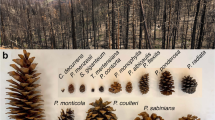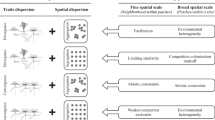Abstract
THE degree to which plants growing together interfere with one another by competing for resources such as light, moisture and nutrients is difficult to determine by direct measurement of resource depletion1. Plant ecologists have therefore looked for indicators of interference in population structure2,3. One proposed measure of interference is the shift that occurs from the ‘normal’ distribution of seed weight to a ‘log-norma’ distribution of the weight of seedlings grown from those seeds in an even-aged monoculture. This shift presumably reflects the emergence of a few large and dominant individuals and the suppression of larger numbers of small individuals. Recently Ford4 and Newbould5 have proposed that distributions of plant weight in competing populations are actually bimodal, resulting from the presence of distinct populations of large individuals with positive relative growth rates and small individuals with nearly zero growth rates. Even-aged plantations of Picea sitchensis demonstrate such disjunct growth rates, and mortality is confined to the smaller individuals4. Size distributions in naturally thinning populations of Abies balsamea and Prunus pensylvanica are also bimodal6. We have studied the distribution of seedling weight in even-aged stands of Festuca paradoxa, a native North American prairie grass7, and report here that although the distribution is bimodal, the bimodality is more striking at lower densities, where interference is less severe. This result is the reverse of that expected if the extent of bimodality were a direct indication of the magnitude of interference. Therefore, although bimodality may be an eventual outcome of interference, it cannot be used as a measure of the strength of interaction between individuals.
This is a preview of subscription content, access via your institution
Access options
Subscribe to this journal
Receive 51 print issues and online access
$199.00 per year
only $3.90 per issue
Buy this article
- Purchase on Springer Link
- Instant access to full article PDF
Prices may be subject to local taxes which are calculated during checkout
Similar content being viewed by others
References
Harper, J. L. Population Biology of Plants (Academic, London, 1977).
Koyama, H. & Kira, T. J. Inst. Polytech. Osaka City Univ. D 7, 73–94 (1956).
Harper, J. L. J. Ecol. 55, 247–270 (1967).
Ford, E. D. J. Ecol. 63, 311–333 (1975).
Ford, E. D. & Newbould, P. J. J. Ecol. 58, 275–296 (1970).
Mohler, C. L., Marks, P. L. & Sprugel, D.G. J. Ecol. 66, 599–614 (1978).
Weaver, J. E. North American Prairie (Johnsen, Lincoln, Nebraska, 1954).
Sokal, R. R. & Rohlf, J. E. Biometry (Freeman, San Francisco, 1969).
Snedecor, G. W. & Cochran, W. G. Statistical Methods, 6th edn (Iowa State University, Ames, 1967).
Gottlieb, L. D. J. Ecol. 65, 127–134 (1977).
Black, J. N. Aust. J. agric. Res. 8, 1–14 (1957), 9, 299–318 (1958).
Ross, M. A. & Harper, J. L. J. Ecol. 60, 77–88 (1972).
Mack, R. N. & Harper, J. L. J. Ecol. 65, 345–363 (1977).
Author information
Authors and Affiliations
Rights and permissions
About this article
Cite this article
RABINOWITZ, D. Bimodal distributions of seedling weight in relation to density of Festuca paradoxa Desv.. Nature 277, 297–298 (1979). https://doi.org/10.1038/277297a0
Received:
Accepted:
Issue Date:
DOI: https://doi.org/10.1038/277297a0
This article is cited by
-
Detecting bimodality in plant size distributions and its significance for stand development and competition
Oecologia (2011)
-
Spatial organisation of a bimodal forest stand
Journal of Forest Research (2010)
-
Comparison of skewness coefficient, coefficient of variation, and Gini coefficient as inequality measures within populations
Oecologia (1989)
-
Some genetic consequences of skewed fecundity distributions in plants
Theoretical and Applied Genetics (1986)
-
A neighbourhood approach to self-thinning
Oecologia (1983)
Comments
By submitting a comment you agree to abide by our Terms and Community Guidelines. If you find something abusive or that does not comply with our terms or guidelines please flag it as inappropriate.



